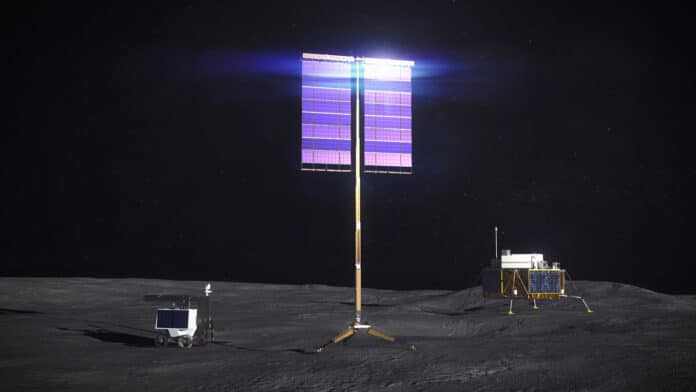NASA continues to work with private companies on various aspects of establishing a future lunar base at the South Pole of the moon. Earlier this week, NASA selected three companies to further advance work on deployable solar array systems that will help power the agency’s human and robotic exploration of the Moon under Artemis.
Through its Artemis lunar exploration program, NASA will return humans to the Moon and establish a long-term presence near the lunar South Pole. For this future robotic and crewed mission, a reliable, sustainable power source is required to support lunar habitats, rovers, and even construction systems. To help provide this power, NASA is supporting the development of vertical solar arrays that can autonomously deploy up to 32 feet high and retract for relocation if necessary.
The agency will award a total of $19.4 million to three companies to continue developing and environmental testing prototype vertical solar arrays that could be positioned at the Moon’s south pole to provide electrical power for a range of future human and robotic operations. The goal is to deploy one of the systems near the Moon’s the South Pole near the end of this decade. The design must remain stable on sloped terrain and be resistant to abrasive lunar dust, all while minimizing both mass and stowed volume to aid in the system’s delivery to the lunar surface.
The three companies selected are Astrobotic Technology, Honeybee Robotics, and Lockheed Martin, each receiving a contract worth between $6 and $7 million.
“These prototypes will provide promising solutions for reliable power sources on the Moon, which are key to the success of almost anything we do on the surface,” said Niki Werkheiser, director of technology maturation in NASA’s Space Technology Mission Directorate (STMD) at NASA Headquarters in Washington. “This exciting effort plays a critical role that will quite literally help power our Artemis exploration in the uniquely challenging environment of the Moon’s the South Pole.”
Current space-rated solar array structures are designed for use in microgravity or for horizontal surface deployment. The vertical orientation and height of these new designs will help prevent loss of power at the lunar poles where the Sun does not rise very far above the horizon. When the Sun is low on the horizon, the Moon’s terrain can block some of its light, keeping it from reaching solar arrays that are low to the ground. By placing the solar arrays on tall masts, these designs allow for uninterrupted light and therefore produce more power.
The contracts are part of the agency’s VSAT project, which aims to support NASA’s long-term lunar surface operations. In 2021, NASA selected five companies to create initial designs for vertical solar array technologies.
